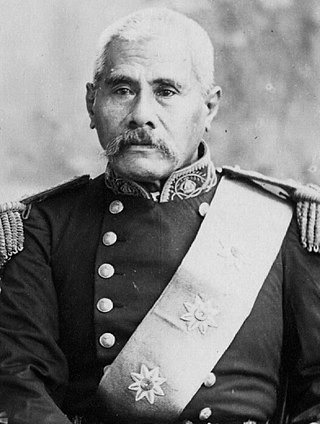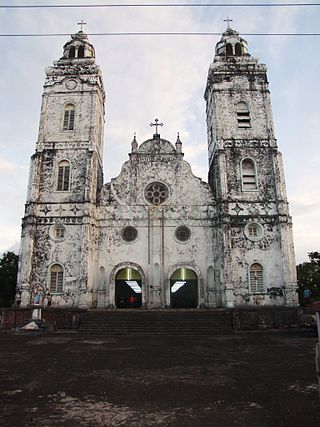Related Research Articles
Samoan culture tells stories of many different deities. There were deities of the forest, the seas, rain, harvest, villages, and war. There were two types of deities, atua, who had non-human origins, and aitu, who were of human origin.
In Samoan mythology, Tagaloa is generally accepted as the supreme ruler, the creator of the universe, the chief of all gods and the progenitor of other gods. Tagaloa Lagi dwelt in space and made the Heavens the sky, the land, the seas, the fresh water, the trees and the people. Samoans believed Tagaloa created nine heavens. Tagaloa's role as paramount deity in the Samoa pantheon bears similarities to the position of Ta'aroa in Tahiti and Io Matua Kore in New Zealand.

Savaiʻi is the largest and highest island both in Samoa and in the Samoan Islands chain. The island is also the sixth largest in Polynesia, behind the three main islands of New Zealand and the Hawaiian Islands of Hawaii and Maui. While it is larger than the second main island, Upolu, it is significantly less populated.

Falealupo is a village in Samoa situated at the west end of Savai'i island 20 miles (32 km) from the International Date Line used until 29 December 2011. The village has two main settlements, Falealupo-Uta, situated inland by the main island highway and Falealupo-Tai, situated by the sea. The road to the coastal settlement is about 9 km, most of it unsealed, from the main highway. The village's population is 545.

Samoans or Samoan people are the Indigenous Polynesian people of the Samoan Islands, an archipelago in Polynesia, who speak the Samoan language. The group's home islands are politically and geographically divided between the Independent State of Samoa and American Samoa, an unincorporated territory of the United States of America. Though divided by national border, the culture and language are the same.

The first three-quarters of the 19th century were marked by tribal warfare, incursions from neighbouring Tonga, and the increasing encroachment of foreign powers. This period also saw the rise of a warlord by the name of Seru Epenisa Cakobau, who forged the first nation-state covering all of modern Fiji in 1871, before ceding it to the United Kingdom in 1874.

Turaga na Vunivalu na Tui Kaba, shortened as Vunivalu, is the Paramount Chief of the Kubuna Confederacy of the island of Bau in Fiji. Loosely translated the title means Warlord of Bau or "Root of War". The succession to the title does not follow primogeniture, but the candidate must be a high-ranking member of the Tui Kaba clan.

Bau is a small island in Fiji, off the east coast of the main island of Viti Levu. Bau rose to prominence in the mid-1800s and became Fiji's dominant power; until its cession to Britain, it has maintained its influence in politics and leadership right through to modern Fiji. Due to its sacred nature, foreigners have to apply for a permit to visit.

Samoa is made up of eleven itūmālō. These are the traditional eleven districts that were established well before European arrival. Each district has its own constitutional foundation (faavae) based on the traditional order of title precedence found in each district's faalupega.

Ātua is an ancient political district of Samoa, consisting of most of the eastern section of Upolu and the island Tutuila. Within Samoa's traditional polity, Ātua is ruled by the Tui Ātua together with the group of six senior orators of Lufilufi and 13 senior matai from throughout Ātua, comprising the Fale Ātua. The fono (meeting) of Atua's rulers takes place in Lufilufi on the great malae of Lalogafu'afu'a.

Gagaʻemauga is a district on the island of Savaiʻi in Samoa. The district is situated on the central north side of Savaiʻi. The name 'Gagaʻemauga' literally means "near side of the mountain", meaning the eastern side of the mountain chain running through the centre of Savaiʻi Island.

Nafanua was a historical ali'i (chief/queen) and toa (warrior) of Samoa from the Sā Tonumaipe'ā clan, who took four pāpā (district) titles, the leading ali'i titles of Samoa. After her death she became a goddess in Polynesian religion.

Mālietoa is a state dynasty and one of the four paramount chiefly titles of Samoa. It is the titular head of one of the two great royal families of Samoa: Sā Malietoa. Literally translated as "great warrior", the title's origin comes from the final words of the Tongan warriors as they were fleeing on the beach to their boats, "Malie To`a, Malo e tau...".
Matautu is the name of different villages in Samoa. Places named Matautu are found on the two largest islands, Upolu and Savaiʻi.

Faʻamatai is the indigenous political ('chiefly') system of Samoa, central to the organization of Samoan society. It is the traditional indigenous form of governance in both Samoas, comprising American Samoa and the Independent State of Samoa. The term comprises the prefix faʻa and the word matai.

The title Tui Manuʻa was the title of the ruler or paramount chief of the Manuʻa Islands in present-day American Samoa.

Safotulafai is a traditional village at the east end of Savai'i island with historical and political significance in Samoa's history. It is the traditional center of the island of Savaii, now became the center of Fa'asaleleaga political district.

Fagamalo is a village situated on the central north coast of Savai'i in Samoa. It is a sub-village or pito nu'u of the larger traditional village enclave of Matautu in the political district of Gaga'emauga. The population of the village is 383.

Sina and the Eel is a myth of origins in Samoan mythology, which explains the origins of the first coconut tree.

Safotu is a village on the central north coast of Savai'i island in Samoa. Safotu is in the district Gagaifomauga and has a population of 1270. Traditionally, it attained the status of 'Pule,' customary political authority, and has been the main centre of the Gagaifomauga district.
References
- 1 2 Barnes, Shawn S.; Hunt, Terry L. (September 2005). "Sāmoa's Pre-Contact Connections in West Polynesia and Beyond". The Journal of the Polynesian Society. 114 (3): 227–266. JSTOR 20707289.
- ↑ Matagi Tokelau: History and traditions of Tokelau. Translated by Hooper, Anthony; Huntsman, Judith. 1991. p. 213. ISBN 9789820200586. OCLC 24637922 . Retrieved November 20, 2018.
- ↑ Mageo, Jeannette Marie (1998). Theorizing Self in Samoa: Emotions, Genders, and Sexualities. University of Michigan Press. p. 181. ISBN 9780472085187 . Retrieved November 20, 2018.
- ↑ Meleisea, Malama; Meleisea, Penelope Schoeffel (1987). Lagaga: A Short History of Western Samoa. p. 42. ISBN 9789820200296 . Retrieved November 20, 2018.
- ↑ Turner, George (1884). Samoa, a Hundred Years Ago and Long Before: Together with Notes on the Cults and Customs of Twenty-three Other Islands in the Pacific . Retrieved November 20, 2018.
- 1 2 Tuimaleali'ifano, Morgan A. (1990). Samoans in Fiji: Migration, Identity and Communication. University of the South Pacific. p. 45. ISBN 9789820200197 . Retrieved November 20, 2018.